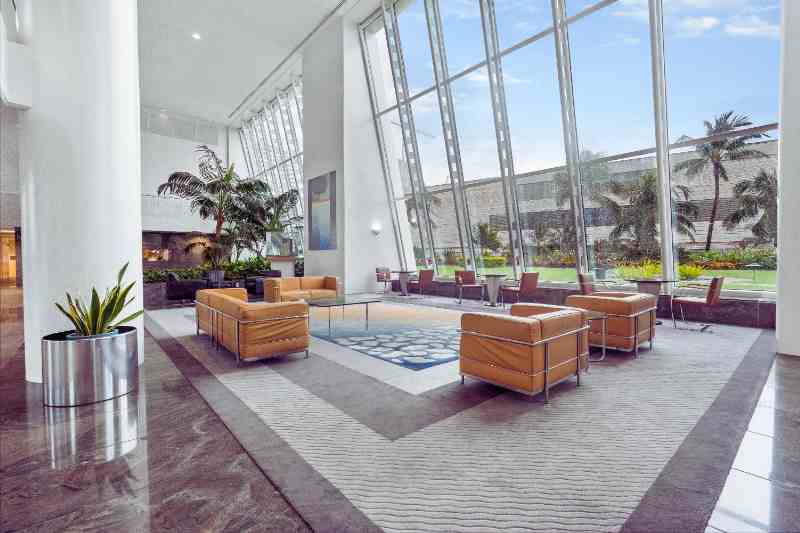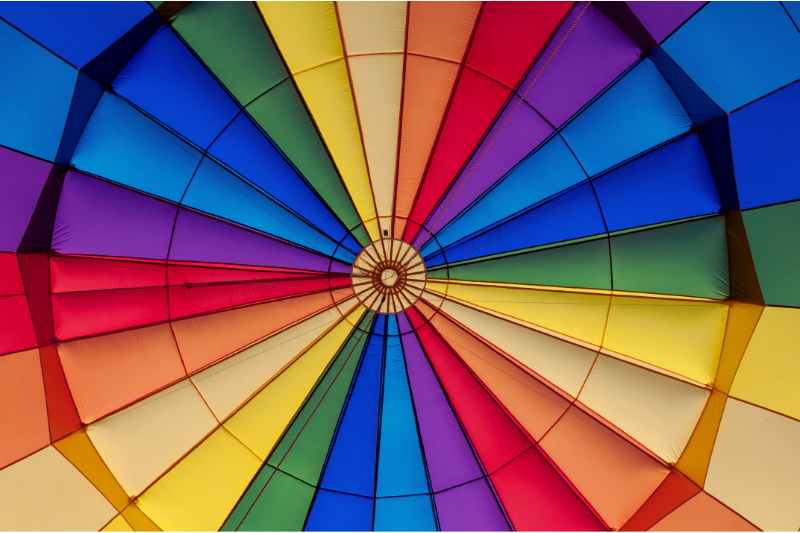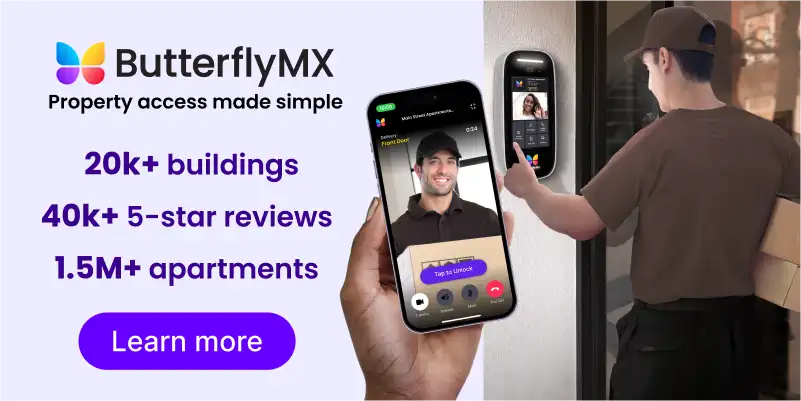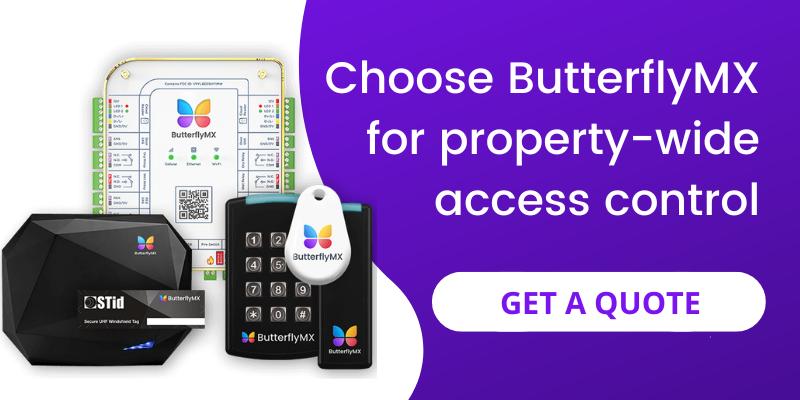Key takeaways
- Designing the interior of multifamily properties involves choosing an aesthetic that is balanced between practicality and attractiveness.
- Good design for a multifamily property will include functionality in the form of seating, a biophilic design that emphasizes natural light, and a color scheme that sets a welcoming tone.
- ButterflyMX offers a number of aesthetically pleasing access control products that work well with a wide variety of design choices for your multifamily property.

Multifamily interior design plays a pivotal role in attracting and retaining tenants and bolstering the resident experience. Whether you oversee apartments, condominiums, or townhomes, creating inviting living spaces enhances tenant satisfaction and boosts occupancy rates. Interior design goes beyond mere aesthetics; it integrates functionality, comfort, and practicality to cater to the diverse needs of residents.
In this post, we review what interior design is and how much it might cost. Next, we go over the specific design elements that you will want to consider. Finally, we will go over the types of proptech that you will want to integrate with your interior design choices.
In this post:
- What is multifamily interior design?
- Key elements of multifamily interior design projects
- Multifamily interior design for functionality and comfort
- Color and texture in multifamily interior design
- Multifamily interior design for proptech
What is multifamily interior design?
Multifamily interior design focuses on creating cohesive and appealing living environments within residential complexes. Unlike single-family homes, multifamily units require considerations such as maximizing space efficiency, accommodating various lifestyles, and adhering to budget constraints while following aesthetic design trends.
Multifamily interior design cost
The cost of designing the interior of your multifamily property varies greatly. For example, if you choose to hire one of the top multifamily interior design firms, then you are likely going to spend more money than you would if you ran to Home Depot for equipment and did it yourself.
Ultimately, your cost is going to depend on a few factors:
- The size of your space. A bigger interior means you will need a bigger budget.
- Redesign vs new design. Redesigning a current space can cost less than designing a new space from scratch. However, this depends on the level of renovations.
- Materials. The types of materials that you use will play a big factor in determining the cost of your property.
Ultimately, you will want to plan on spending between $1,000 and $10,000.
See how ButterflyMX elevates your property’s interior design:
Key elements of multifamily interior design projects
- Space utilization. Efficient use of space is paramount in multifamily units. Designers often employ strategies like open floor plans, modular furniture, and clever storage solutions to maximize usable area without compromising on comfort.
- Aesthetic cohesion. Establishing a consistent design language throughout the property enhances its overall appeal. This involves selecting complementary color schemes, textures, and materials that reflect the desired atmosphere, whether it’s contemporary, minimalist, or classic.
- Durability and maintenance. Given the high turnover in rental properties, durability is crucial. Opting for sturdy, easy-to-clean materials and finishes reduces maintenance costs and ensures longevity, making it an attractive investment for property managers.
Multifamily interior design for functionality and comfort
When designing multifamily interiors, prioritizing functionality and comfort ensures tenant satisfaction and enhances the property’s marketability.
Here are some strategies to achieve this balance:
- Flexible living spaces. Integrating versatile furniture and multi-functional layouts allows residents to adapt spaces to their specific needs, whether it’s working from home, entertaining guests, or relaxing after a long day. Listen to what your resident’s needs are and gain this information by providing a resident satisfaction survey.
- Well-designed kitchens and bathrooms. These are key selling points for prospective tenants. Incorporating modern appliances, ample storage, and ergonomic layouts enhances convenience and usability, while stylish fixtures and finishes elevate the overall aesthetic appeal.
- Natural light and ventilation. Maximizing natural light and airflow not only reduces energy costs but also creates a welcoming ambiance. Large windows, skylights, and balconies enhance indoor-outdoor connectivity, fostering a sense of openness and well-being.
Current trends in multifamily interior design
As the preferences and lifestyles of tenants evolve, so do interior design trends in multifamily properties.
Stay updated with the following trends:
- Smart home technology. Integrating smart devices and automation systems enhances convenience and energy efficiency. Features like smart thermostats, lighting controls, and access control systems appeal to tech-savvy tenants seeking modern amenities. Smart home technology integrates well with existing property software, such as apartment community phone apps.
- Sustainable design practices. Increasingly, tenants prioritize eco-friendly living spaces. Utilizing sustainable materials, energy-efficient appliances, and water-saving fixtures not only reduces environmental impact but also attracts environmentally conscious renters.
- Biophilic design. Incorporating elements of nature such as indoor plants, natural materials, and views of green spaces promotes well-being and reduces stress among residents. Biophilic design elements can be seamlessly integrated into communal areas and individual units alike.
Color and texture in multifamily interior design
Color and texture profoundly impact the atmosphere and perceived spaciousness of multifamily units. The impact of color also affects the mood and mental health of your residents and staff.
Color transforms interiors by:
- Choosing the right color palette. Neutral tones like whites, grays, and beiges create a timeless backdrop that appeals to a wide range of tastes. Accent colors can be used sparingly to add personality and visual interest without overwhelming the space.
- Texture for depth and dimension. Mixing textures such as smooth surfaces, plush fabrics, and natural materials adds depth to interiors and creates a tactile experience. Textured wallpapers, area rugs, and upholstered furniture pieces can enhance comfort and aesthetic appeal.

Multifamily interior design for proptech
When choosing the interior design for your multifamily property, we recommend going with a style that incorporates your proptech devices around your property. Specifically, you should consider your property’s access control systems, as these are often located in close proximity to the first spaces in your building that residents and guests enter.
Our company, ButterflyMX, offers a suite of aesthetically pleasing access control products that complement most design choices. ButterflyMX is currently installed in over 10,000 buildings and has over 20,000 five-star reviews.
Products like our ButterflyMX Video Intercom offer a sleek and attractive design that is both technologically sophisticated and attractive. Our screen’s purple color scheme offers an alluring pop of color that also serves to direct residents and their guests to the intercom so that they know what to use to enter the property and amenity spaces.

Aesthetically pleasing ButterflyMX products
Some of the aesthetically pleasing access control products that ButterflyMX offers include:
- Keypads. Our keypads offer versatile entry options such as PIN codes, fobs, and key cards. Residents can also use the ButterflyMX mobile app on their smartphones for seamless access. Temporary PIN codes can be assigned to guests, with each entry event securely recorded and timestamped in the cloud for added security.
- Card and fob readers. We offer card and fob readers that support key cards, key fobs, and mobile credentials, ensuring flexibility and convenience for residents and staff alike.
- Video Intercoms. Our intercom offers face-to-face communication that residents can speak through via their mobile devices.
- Vehicle Reader. Our Vehicle Reader is what residents will encounter before entering the building. All residents and staff members have to do is place a windshield tag on their vehicle. The Vehicle Reader will then scan the windshield tag and grant entry to a gated property or gated parking garage.
- Front Desk Station Software. Our front desk station software will minimize the clunky hardware and awkward staging of a literal front desk. Instead, you can communicate with residents through the mobile app and video intercom to answer any questions they might have and manage access permissions.







